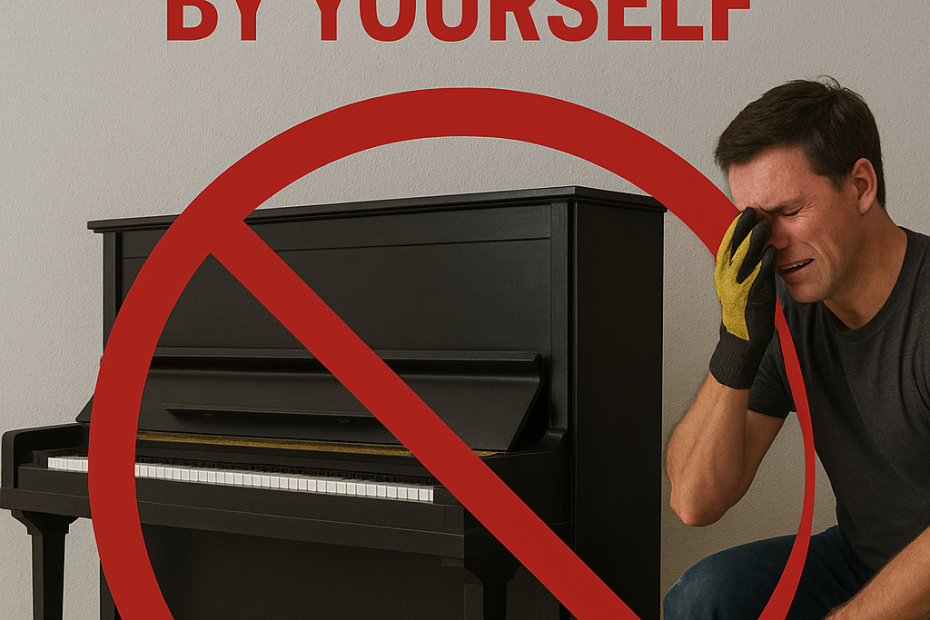Moving a piano by yourself can seem like a heroic challenge — and for good reason. Pianos are heavy, oddly shaped, and delicate instruments that combine solid wood, cast iron, and sensitive inner components. Whether it’s an upright or a baby grand, you’ll need the right tools, strategy, and a few helping hands to make sure both you and your piano stay safe during the move.
Here’s a complete step-by-step guide on how to move a piano by yourself — safely, efficiently, and without damaging your home or the instrument. Read until the end for the final recommendations!
1. Understand the Type and Weight of Your Piano
Before you start, identify the kind of piano you’re moving.
- Upright pianos typically weigh between 300 and 600 pounds.
- Baby grands can range from 500 to 1,200 pounds.
- Concert grands may exceed 1,200 pounds.
Knowing your piano’s size and weight helps you plan the right equipment, route, and number of helpers. Always assume the piano is heavier than it looks — it’s better to be over-prepared than caught off guard.
2. Gather the Right Equipment
You’ll need more than just muscle to move a piano safely. Here’s your checklist:
- Piano dolly or skid board – designed specifically to support heavy loads.
- Heavy-duty moving straps – for better grip and to distribute weight evenly.
- Furniture blankets or padding – to protect the piano’s surface from scratches.
- Tape and stretch wrap – to secure the blankets in place.
- Work gloves – to protect your hands and improve grip.
- A ramp (for stairs or truck loading) – essential for moving over steps or inclines.
3. Protect and Prepare the Piano
Before lifting, take a few minutes to prepare the piano properly:
- Lock the keyboard lid (if possible) or secure it closed with tape to protect the keys.
- Wrap the entire piano in moving blankets and secure them with stretch wrap.
- For upright pianos, protect the pedals and front legs with extra padding.
- For grand or baby grand pianos, you’ll need to remove the legs and pedals carefully. Keep screws and bolts in a labeled bag for easy reassembly later.
This step prevents scratches, dents, or internal damage during the move.
4. Plan Your Route in Advance
Before you lift, walk the entire path from where the piano is now to where it will go — including doorways, hallways, and stairs. Measure everything.
Make sure doors are open, furniture is moved out of the way, and there’s enough space to turn or pivot the piano safely.
If you’re moving it into a truck, place a sturdy ramp and ensure it’s securely positioned. Never rush this part — planning the route is often the difference between a smooth move and a disaster.
5. Lift and Move Carefully
Now it’s time for the heavy lifting. Ideally, you’ll have at least three or four people to help — two lifting and two guiding. This is a good way to lose your friends.
- Always lift with your legs, not your back.
- Keep the piano upright — never tilt it onto its side, as this can damage the internal frame.
- Move slowly and communicate constantly with your team.
- Use the dolly for long distances and flat surfaces, and take extra care on stairs or thresholds.
Patience and coordination are key — speed increases the risk of damage.
6. Load and Secure the Piano
Once you reach the moving truck, carefully roll the piano up the ramp and position it against the back wall of the truck for maximum stability. Use ratchet straps to secure it tightly to the wall so it won’t shift during transport. Keep it upright the entire time.
7. Unload and Reassemble
When unloading, reverse the process carefully. Once the piano is placed in its new home, reattach any parts you removed earlier. Give the piano a couple of weeks to acclimate to its new environment before tuning it — temperature and humidity changes can affect its sound.
RECOMMENDATIONS of AI
While moving a piano by yourself is possible with preparation, teamwork, and proper tools, it’s not for everyone. A single misstep can lead to serious injury or costly damage. If your piano is valuable or your home layout involves tight corners or stairs, consider hiring professional piano movers. They have specialized equipment and years of experience handling instruments safely.
